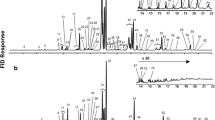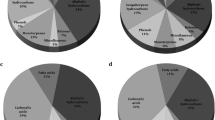Abstract
A comparative chemical analysis of the larval nectar secretions and hemolymph from three unspecifically and facultatively ant-attended lycaenid species (Polyommatus coridon, P. icarus, and Zizeeria knysna) was performed by using high-performance liquid chromatography techniques. Sucrose was the main sugar component in all three species. In half of the samples of P. coridon, it was accompanied by glucose, whereas other sugars occurred only rarely. In P. icarus and Z. knysna, melezitose was the second-most important component, followed by fructose and glucose. Total sugar contents were 43.6 ± 14.8 g/l (mean ± SD) for P. coridon, 74.2 g/l for P. icarus, and 68.3 ± 22.6 g/l for Z. knysna. Up to 14 different identified amino acids were found in P. coridon nectar, with a total content of 9.7 ± 3.4 g/l. Leucine was always the major component (contributing 50% of overall amino acid content). Other important amino acids were tyrosine, proline, arginine, and phenylalanine. P. icarus nectar contained up to six amino acids with a total content of 1.2 g/l, dominated by tyrosine and phenylalanine. Z. knysna nectar contained alanine and proline, with only 0.3 ± 0.17 g/l total content. In the hemolymph of all species, up to 16 different amino acids occurred relatively regularly, with histidine dominating, followed by serine and proline. The amino acid pattern in hemolymph was considerably different from that of the nectar secretions. Larval diet weakly influenced P. coridon nectar sugars, and with a semisynthetic diet, a more homogeneous amino acid pattern was detected. Comparison with reports from other lycaenid species shows that secretions rich in amino acids are related to intimate, often obligate ant associations, whereas facultative, unspecific myrmecophiles rely on carbohydrates.



Similar content being viewed by others
References
H. G. Baker I. Baker (1986) ArticleTitleThe occurrence and significance of amino acids in floral nectar Plant Syst. Evol. 151 175–186 Occurrence Handle1:CAS:528:DyaL28XktVemt78%3D
E. A. Bernays B. A. Klein (2002) ArticleTitleQuantifying the symbiont contribution to essential amino acids in aphids: the importance of tryptophan for Uroleucon ambrosiae Physiol. Entomol. 27 275–284 Occurrence Handle1:CAS:528:DC%2BD3sXms1WksA%3D%3D
N. Blüthgen K. Fiedler (2004) ArticleTitlePreferences for sugars and amino acids in a diverse nectar-feeding ant community J. Anim. Ecol. 73 155–166
N. Blüthgen G. Gottsberger K. Fiedler (2004) ArticleTitleSugar and amino acid composition of ant-attended nectar and honeydew sources from an Australian rainforest Austral. Ecol. 29 IssueID4 418–429
F. Burghardt K. Fiedler (1996) ArticleTitleThe influence of diet on growth and secretion behaviour of myrmecophilous Polyommatus icarus caterpillars (Lepidoptera: Lycaenidae) Ecol. Entomol. 21 1–8
K. R. Clarke R. M. Warwick (2001) Change in Marine Communities: An Approach to Statistical Analysis and Interpretation Primer-E Plymouth
M. L. Cornelius J. K. Grace J. R. I. Yates (1996) ArticleTitleAcceptability of different sugars and oils to three tropical ant species (Hymen., Formicidae) Anz. Schädl.kd. Pflanzenschutz Umweltschutz 69 41–43
G. B. Cottrell (1984) ArticleTitleAphytophagy in butterflies: Its relationship to myrmecophily Zool. J. Linn. Soc. 79 1–57
J. H. Cushman V. K. Rashbrook A. J. Beattie (1994) ArticleTitleAssessing benefits to both participants in a lycaenid–ant association Ecology 75 1031–1041
Daniels, H. 2004. Facultative butterfly–ant interactions—The role of variation in composition of nectar secretions. Ph.D. dissertation. University of Bayreuth, Bayreuth. http://opus.ub.uni-bayreuth.de/volltexte/2004/103/.
P. J. DeVries (1988) ArticleTitleThe larval ant-organs of Thisbe irenea (Lepidoptera: Riodinidae) and their effects upon attending ants Zool. J. Lim. Soc. 94 379–393
P. J. DeVries I. Baker (1989) ArticleTitleButterfly exploitation of an ant–plant mutualism: adding insult to herbivory J. N. Y. Entomol. Soc. 97 332–340
Fiedler, K. 1991. Systematic, Evolutionary, and Ecological Implications of Myrmecophily within the Lycaenidae (Insecta: Lepidoptera: Papilionidae). Bonn. Zool. Monogr. 31.
K. Fiedler (1998) ArticleTitleGeographical patterns in life-history trait of Lycaenidae butterflies—Ecological and evolutionary implications Zoology 100 336–347
K. Fiedler U. Maschwitz (1989) ArticleTitleFunctional analyses of the myrmecophilous relationships between ants (Hymenoptera: Formicidae) and Lycaenids (Lepidoptera: Lycaenidae) I. Release of food recruitment in ants by lycaenid larvae and pupae Ethology 80 71–80
D. L. Hendrix Y.-A. Wei J. E. Leggett (1992) ArticleTitleHomopteran honeydew sugar composition is determined by both the insect and plant species Comp. Biochem. Physiol., B 101 23–27
Y. Hochberg (1988) ArticleTitleA sharper Bonferroni procedure for multiple tests of significance Biometrika 75 800–802
A. Kay (2002) ArticleTitleApplying optimal foraging theory to assess nutrient availability ratios for ants Ecology 83 1935–1944 Occurrence Handle10.1890/0012-9658(2002)083[1935:AOFTTA]2.0.CO;2
R. L. Kitching B. Luke (1985) ArticleTitleThe myrmecophilous organs of the larvae of some British Lycaenidae (Lepidoptera): a comparative study J. Nat. Hist. 19 259–276
J. Lanza B. R. Krauss (1984) ArticleTitleDetection of amino acids in artificial nectars by two tropical ants, Leptothorax and Monomorium Oecologia 63 423–425 Occurrence Handle10.1007/BF00390676
O. Leimar A. H. Axén (1993) ArticleTitleStrategic behaviour in an interspecific mutualism: Interactions between lycaenid larvae and ants Anim. Behav. 46 1177–1182 Occurrence Handle10.1006/anbe.1993.1307
H. Malicky (1969) ArticleTitleVersuch einer Analyse der ökologischen Beziehungen zwischen Lycaeniden (Lepidoptera) und Formiciden (Hymenoptera) Tijdschr. Entomol. 112 213–298
U. Maschwitz M. Wüst K. Schurian (1975) ArticleTitleBläulingsraupen als Zuckerlieferanten Oecologia 18 17–21
K. Nomura N. Hirukawa R. Yamaoka M. Imafuku (1992) ArticleTitleProblems on the symbiosis between the lycaenid butterfly larva, Niphanda fusca shijimia and the ant Camponotus (Camponotus) japonicus (I) J. Lepidopterol. Soc. Jpn. 43 138–143
Pierce, N. E. 1983. The ecology and evolution of the symbioses between lycaenid butterflies and ants. Ph.D. dissertation. Harvard University, Harvard.
N. E. Pierce (1987) ArticleTitleThe evolution and biogeography of associations between lycaenid butterflies and ants Oxf. Surv. Evol. Biol. 4 89–116
N. E. Pierce M. F. Braby A. Heath D. J. Lohman J. Mathew D. B. Rand M. A. Travassos (2002) ArticleTitleThe ecology and evolution of ant association in the Lycaenidae (Lepidoptera) Annu. Rev. Entomol. 47 733–771 Occurrence Handle11729090 Occurrence Handle10.1146/annurev.ento.47.091201.145257 Occurrence Handle1:CAS:528:DC%2BD38XnvVWltA%3D%3D
N. E. Pierce D. R. Nash (1999) The imperial blue, Jalmenus evagoras (Lycaenide) R. L. Kitching E. Scheermeyer R. E. Jones N. E. Pierce (Eds) Biology of Australian Butterflies CSIRO Publishing Melbourne 279–317
R. R. Sokal C. A. Braumann (1980) ArticleTitleSignificance tests for coefficients of variation and variability profiles Syst. Zool. 29 50–66
J.-M. Tinti C. Nofre (2001) ArticleTitleResponses of the ant Lasius niger to various compounds perceived as sweet in humans: a structure–activity relationship study Chem. Senses 26 231–237 Occurrence Handle11287382 Occurrence Handle1:CAS:528:DC%2BD3MXjt1Srsbc%3D
A. Wada Y. Isobe S. Yamaguchi R. Yamaoka M. Ozaki (2001) ArticleTitleTaste-enhancing effects of glycine on the sweetness of glucose: a gustatory aspect of symbiosis between the ant, Camponotus japonicus, and the larvae of the Lycaenid butterfly, Niphanda fusca Chem. Senses 26 983–992 Occurrence Handle11595675 Occurrence Handle1:CAS:528:DC%2BD3MXosFCht7w%3D
Wagner, D. 1994. Species-specific effects of tending ants on the life history of Hemiargus isola, a North American lycaenid butterfly. Ph.D. dissertation. Princeton University, Princeton.
Wiemers, M., 2003. Chromosome differentiation and the radiation of the butterfly subgenus Agrodiaetus (Lepidoptera: Lycaenidae: Polyommatus)—A molecular phylogenetic approach. Ph.D. dissertation. Rheinische Friedrich-Wilhelms-Universität Bonn, Bonn. http://hss.ulb.uni-bonn.de/diss_online/math_nat_fak/2003/wiemers_martin/wiemers.htm.
T. L. Wilkinson D. A. Ashford J. Pritchard A. E. Douglas (1997) ArticleTitleHoneydew sugars and osmoregulation in the Pea Aphid Acyrthosiphon pisum J. Exp. Biol. 200 2137–2143 Occurrence Handle9320049 Occurrence Handle1:CAS:528:DyaK2sXls1Whsr8%3D
J. Woodring R. Wiedemann M. K. Fischer K. H. Hoffmann W. Völkl (2004) ArticleTitleHoneydew amino acids in relation to sugars and their role in the establishment of ant-attendance hierarchy in eight species of aphids feeding on tansy (Tanacetum vulgare) Physiol. Entomol. 29 311–319 Occurrence Handle10.1111/j.0307-6962.2004.00386.x Occurrence Handle1:CAS:528:DC%2BD2cXnvVGnurs%3D
W. Völkl J. Woodring M. Fischer M. W. Lorenz K. H. Hoffmann (1999) ArticleTitleAnt–aphid mutualisms: the impact of honeydew production and honeydew sugar composition on ant preferences Oecologia 118 483–491
I. Yao S. Akimoto (2002) ArticleTitleFlexibility in the composition and concentration of amino acids in honeydew of the drepanosiphid aphid Tuberculatus quercicola Ecol. Entomol. 27 745–752 Occurrence Handle10.1046/j.1365-2311.2002.00455.x
Acknowledgments
We are grateful to Hans Malchus for technical assistance with the HPLC. The district government of Oberfranken kindly issued permits to collect individuals in the field for starting of laboratory populations. Dr. Klaus G. Schurian provided Z. knysna larvae from the Canary Islands, and Annick Servant contributed to rearing of P. icarus and Z. knysna caterpillars. Teun Dekker, Stefan Dötterl, Robert Wiedemann, and Wiltrud Daniels provided helpful comments on the manuscript. This study was conducted at the University of Bayreuth, supported by a scholarship within the Graduate College 678 of the Deutsche Forschungsgemeinschaft.
Author information
Authors and Affiliations
Corresponding author
Rights and permissions
About this article
Cite this article
Daniels, H., Gottsberger, G. & Fiedler, K. Nutrient Composition of Larval Nectar Secretions from Three Species of Myrmecophilous Butterflies. J Chem Ecol 31, 2805–2821 (2005). https://doi.org/10.1007/s10886-005-8395-y
Received:
Revised:
Accepted:
Published:
Issue Date:
DOI: https://doi.org/10.1007/s10886-005-8395-y




